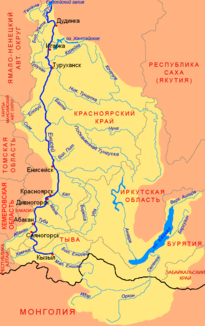Great cheta
|
Big Cheta Большая Хета (Bolshaya Cheta) |
||
|
Location of the Great Cheta (Большая Хета) in the catchment area of the Yenisei |
||
| Data | ||
| Water code | RU : 17010800412116100107890 | |
| location | Krasnoyarsk Region ( Russia ) | |
| River system | Yenisei | |
| Drain over | Yenisei → Arctic Ocean | |
| source | Jelowoe Lake northwest of Igarka 67 ° 59 ′ 44 ″ N , 84 ° 33 ′ 42 ″ E |
|
| Source height | approx. 150 m | |
| muzzle |
Yenisei northwest of Dudinka Coordinates: 69 ° 33 ′ 35 " N , 84 ° 16 ′ 43" E 69 ° 33 ′ 35 " N , 84 ° 16 ′ 43" E |
|
| Mouth height | approx. 1 m | |
| Height difference | approx. 149 m | |
| Bottom slope | approx. 0.23 ‰ | |
| length | 646 km | |
| Catchment area | 20,700 km² | |
| Drain |
MQ |
211 m³ / s |
| Left tributaries | Pokoinizkaya, Lodochnaja, Njungnjagda | |
| Right tributaries | Yachinda, Soljonaya | |
| Communities | Tuchard | |
| Navigable | 46 km | |
The Great Cheta ( Russian Большая Хета , Bolshaya Cheta ) is a 646 km long left tributary of the Yenisei in the West Siberian lowlands in the Asian part of Russia . It is not to be confused with the left source river Cheta of the Chatanga , a few hundred kilometers to the east.
course
The Great Cheta flows at a height of about 150 m from the Jelowoje Lake (" Spruce lake", also called Tscheskanama Lake) in the northeast of the West Siberian lowlands, in the northwest of the Krasnoyarsk region and a good 100 kilometers northwest of the city of Igarka . The upper course of the river is therefore also known under the name Jelowaja (Russian Еловая , "spruce river").
The Great Cheta initially flows through the forest tundra landscape for several dozen kilometers in a south-easterly direction before turning sharply to the north-west. In the further course, it maintains a general direction of flow to the north, meandering mainly in large arches . On a plurality of portions it marks the boundary of the Rajons Turuchansk to the former autonomous district Taimyr on whose territory they otherwise runs. The river finally flows into the lower course about 75 kilometers west-northwest of Dudinka in the left arm of the Yenisei, almost three kilometers wide and in places more than 40 meters deep, which already merges into its confluence there and is under the influence of tides . The Great Cheta is over 500 meters wide and four meters deep near the mouth; the flow velocity there is 0.2 m / s.
Hydrology
The catchment area of the Great Cheta covers 20,700 km². It has several larger tributaries, including Pokoinizkaja ("Dead River", also Bunilbiratyn), Lodotschnaja ("Boat River") and Njungnjagda from the left as well as Jachinda and Soljonaja ("Salt River", also Chakdybira) from the right.
Use and infrastructure
The Great Cheta is navigable from the middle reaches, but is only considered an inland waterway for the lower 46 km from the Semjonowski settlement .
The river is said to be rich in fish.
The area through which it flows is very sparsely populated. The only village on the river is Tuchard on the left bank of the lower course, with the associated district of Semjonowski a few kilometers upstream. It belongs to the rural community (Selskoje posselenije) Karaul , whose administrative center of the same name is located almost 100 kilometers north on the right bank of the Yenisei. Tuchard south and Semenovsky intersect the flow of several strands of opened in 1969, 263 km long pipeline that on the border at the autonomous district of Yamalia lying natural gas reservoir Messoyakha River begins and the fuel supply to the mining area to Norilsk used. There is no traffic infrastructure in the area in the form of roads.
Individual evidence
- ↑ a b c Article Great Cheta in the Great Soviet Encyclopedia (BSE) , 3rd edition 1969–1978 (Russian)
- ↑ a b Great Cheta in the State Water Register of the Russian Federation (Russian)
- ↑ Soviet General Staff Map 1: 200,000, sheet Q-45-I, II (1989 edition)
- ^ List of Inland Waterways of the Russian Federation (confirmed by Order No. 1800 of the Government of the Russian Federation of December 19, 2002); on-line
- ↑ Messojacha – Norilsk ( page no longer available , search in web archives ) Info: The link was automatically marked as defective. Please check the link according to the instructions and then remove this notice. in Fakel Taimyra ( Norilskgasprom corporate magazine ), No. 5/2009 (Russian)
